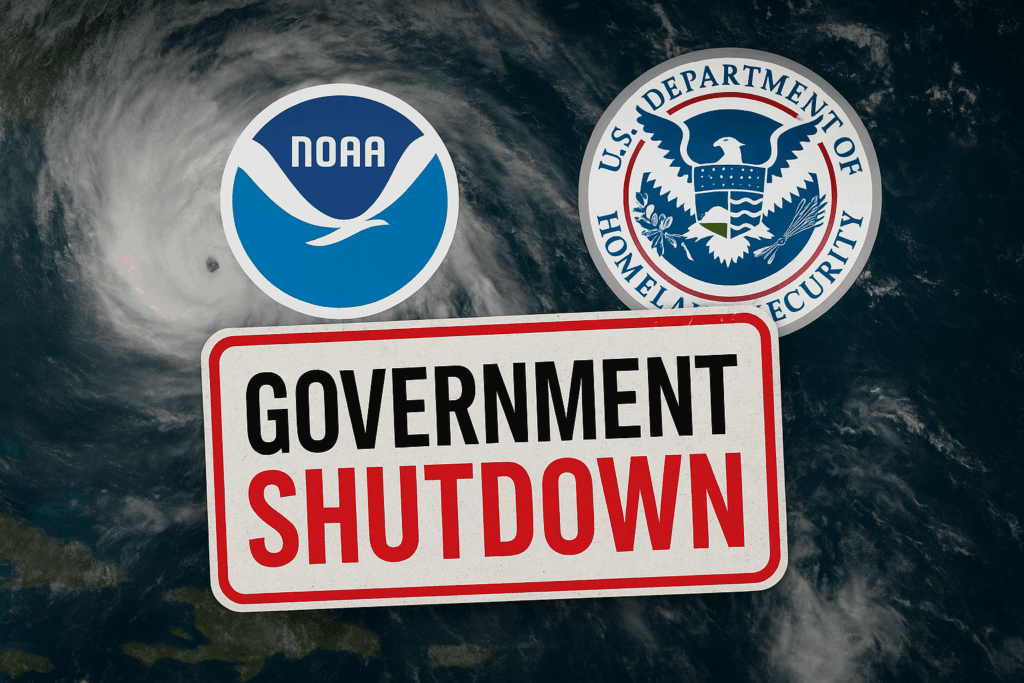With two major tropical systems looming off the Southeast coast, a potential federal government shutdown threatens readiness and response during the heart of hurricane season—even as agencies like NOAA and FEMA attempt to maintain critical operations.
Weather forecasters and disaster response specialists are typically exempt from furlough during shutdowns. Agency leaders say they plan to keep working this time as well. However, the deeper problem is structural: both NOAA and FEMA enter this looming shutdown in weakened states, having suffered years of staff losses and internal turmoil. The capacity to forecast, prepare, and respond may be stretched beyond its limit.
Struggles at NOAA and the National Weather Service
At the National Weather Service (NWS), which operates under NOAA, leaders are scrambling to maintain essential services amid severe staffing gaps. The agency has fewer than 4,000 employees — the lowest level in decades. It has lost more than 560 workers through retirements, attrition, and early departure incentives under the current administration. Local offices are already short on personnel needed for twice-daily weather balloon launches, as well as continuous staffing and maintenance operations.
An unnamed NOAA official told CNN that during Tropical Storm Imelda, the agency redirected staff to its coastal forecast offices to help with surging demand. The official said most forecasters and technicians are expected to be exempt from furloughs. Hurricane-hunter aircraft crews are likewise typically spared. Still, they cautioned, “storm forecasts would not suffer … but … the real problem will be the response.”
A second NOAA source, also speaking anonymously, expressed frustration that guidance from the Office of Management and Budget had not yet been finalized. They called it “remarkable” that shutdown plans remain unfinished this late. NOAA spokesperson Kim Doster declined to elaborate, stating only that the agency’s “products and services” would continue.
Experts warn that the damage already done sets the agency up to falter under duress. The Brookings Institution notes that the Trump administration’s deep cuts to NOAA and NWS “will be really difficult to rebuild.” The American Progress policy group likewise warns of long-term losses in forecasting capabilities. They note proposed further budget reductions in 2026.
Meteorologists warn that losing critical microwave satellite data could degrade intensity forecasts. One expert said accuracy could drop 20%–40% if AOML were closed. Former AOML director Robert Atlas emphasized the lab’s importance for maintaining hurricane model accuracy.
Six NWS forecast offices have already cut overnight operations, and balloon launches have dropped. Some offices have 35% vacancy rates.
FEMA’s exposure to the storm of budget cuts
FEMA is similarly vulnerable. Many disaster response functions are funded via the Disaster Relief Fund, shielding some field teams from furlough. However, the agency’s headquarters, support staff, and nonemergency programs face disruption.
Top officials may continue to be recalled as needed for disaster response. But the infrastructure to coordinate efforts may erode. In 2025 alone, FEMA reportedly lost nearly a third of its full-time workforce through staff reductions and leadership changes.
Former FEMA Administrator Deanne Criswell warned that a shutdown could result in fewer leaders and support staff, potentially impacting FEMA’s ability to carry out its mission.
A disaster response official told CNN that the remaining staff would be less prepared without pay and expected a shutdown to be unnecessarily challenging.
Even programs funded outside emergency relief — such as resilience and mitigation projects — would come to a halt. The National Flood Insurance Program, which expires on September 30, would cease issuing new policies. However, it would still honor active claims.
The repercussions would cascade: FEMA often relies on other federal agencies for logistics, data, and support. Deep furloughs elsewhere could cripple coordination. This problem remains even if some FEMA teams stay intact.
The hazard of timing and austerity
Hurricane season lasts through November—the time when federal operations are most needed. A shutdown during peak storm conditions would delay communication, disrupt evacuation plans, slow resource deployment, and weaken coordination among federal, state, and local authorities.
The contrast is stark: NOAA’s role is to provide public warnings by forecasting storms, while FEMA’s is to execute emergency responses and provide aid. Yet with both agencies stretched thin, forecasting may still succeed while response falters.
Cutting NOAA’s capacity by closing labs, reducing data, and ending research weakens future hurricane forecasting. FEMA’s new constraints and less funding hurt resilience and emergency readiness.
With two storms off the Southeast, the stakes are high. Lives and infrastructure are at risk. A shutdown now would prove that inaction and budget cuts can be more damaging than any storm.


